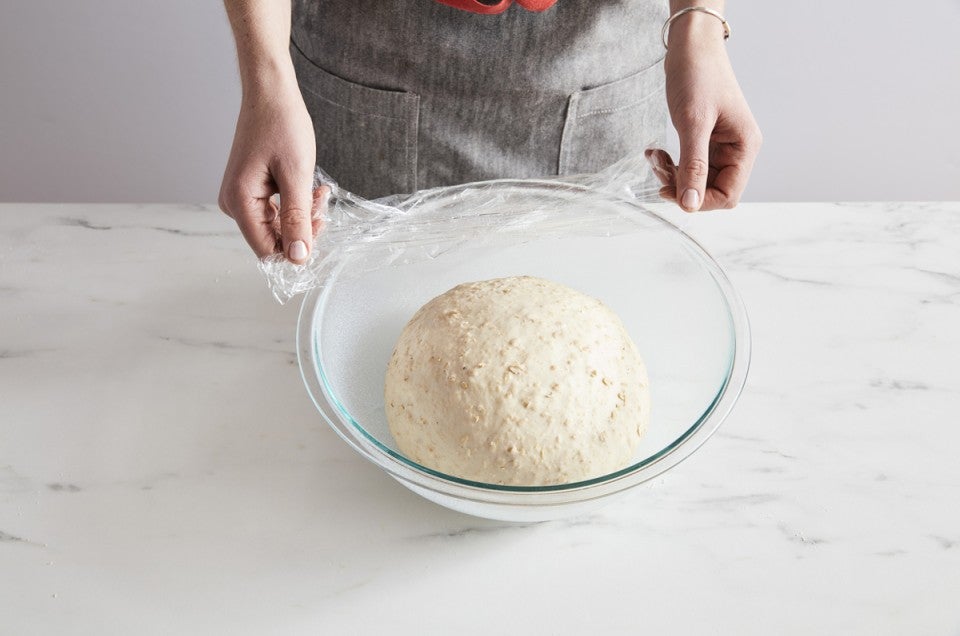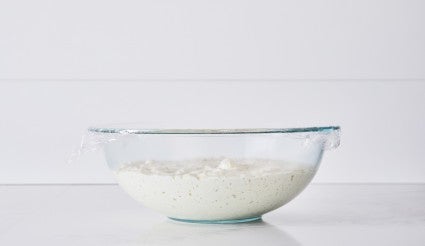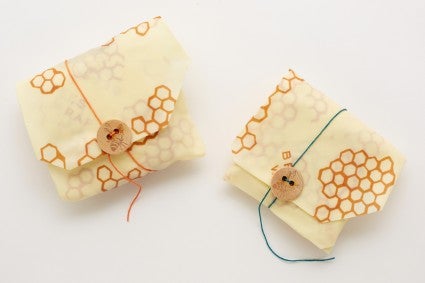How can I get single-use plastic out of my baking?
Simple switches can help cut down on how much plastic we waste when we bake.


I didn’t really think about how much plastic was in my baking until I started paying attention. There were the sandwich bags I stuffed with leftover brownies. The disposable pastry bags I used to pipe swirls of buttercream. And the plastic wrap ... so much plastic wrap. To cover my proofing bread dough, store my leftover cake, wrap my frozen cookies, and plenty more.
I’ve been thinking deeply about how I can incorporate more environmentally friendly practices into my baking, and one thing has become clear: Decreasing my consumption of single-use plastic is a necessary place to start.
As with most topics related to environmental sustainability, there are no clear-cut, easy answers to the problem of plastic. But after a little bit of searching, I found a lot of ways to leave the plastic wrap on the roll. How you bake in your own kitchen depends on your individual circumstances, and what’s right for me may not be the best choice for you. But if you’re tired of buying plastic baggies only to throw them away a week later, read on.

The meaning of single-use plastic is right there in the name: It’s meant to be used one time, then discarded. In baking, the most common example is plastic wrap, used for countless important tasks — everything from storing leftover baked goods to preventing doughs from drying out.
Of course, there are ways to reuse plastic products intended for a single use, like washing a plastic sandwich bag. That said, such products will eventually wear down, and in time they’ll have to be discarded and replaced.
According to a report by the Center for International Environmental Law, “plastic proliferation threatens our planet and the climate at a global scale.” That threat is for a variety of reasons. For one, making plastic products is resource-intensive; the more we use plastic, the more resources are required to make more of it. According to that same report, “Nearly every piece of plastic begins as a fossil fuel, and greenhouse gases are emitted at each stage of the plastic lifecycle.”
Then, once disposed of, plastic can wind up in oceans and lead to waterway pollution, something the United Nations has deemed “a planetary crisis.” It can also end up in landfills, where it takes a long time to degrade, if at all. That discarded plastic leads to microplastics that leach into the soil, where it can have a damaging effect on soil health. What’s more, discarded plastic that ends up in landfills and incinerators can release greenhouse gasses that contribute to global climate change; according to this report by the EPA, in 2016 more than half the emissions from the incineration of waste in the U.S. was attributable to the combustion of plastics.
It’s clear plastic consumption is a huge issue for our planet. And sure, it can be hard to grasp how one less sheet of plastic wrap really makes a difference. But personally, I’m trying to do all I can to minimize my negative impact on our planet. This is something we can all seek to address in every part of our lives, but as bakers, here are some ways we can eliminate use specifically in our kitchens.
(Heads up: At King Arthur, we only recommend the products that we, as bakers, truly love. When you buy through external links on our site, we may earn an affiliate commission.)

This is one area in which I use the most plastic. Instead of automatically reaching for that roll of plastic wrap, try using something else to keep doughs from drying out:
Bee’s Wrap: You may be familiar with this product, a washable, reusable, and fully biodegradable wrap that clings, sticks, and seals like plastic. It’s great for covering bowls and pans, plus wrapping pie dough while it chills (and plenty of other uses — this won’t be the last time it’s recommended).
Plates, pans, and lids: As long as a plate, pan, or saucepan lid is big enough to cover a bowl opening and flat enough to be fully flush to the rim, it makes a nice DIY reusable bowl cover.
Reusable bowl covers or storage bowls with a reusable lid: Of course, if you bake a lot you might want to upgrade to a real reusable bowl cover. These are big favorites for many King Arthur bakers. You can also find sheet pans with reusable covers for bakes like cinnamon rolls or bagels.
Dough-rising buckets: Basically a storage bowl with a lid, but made specifically for bread!
Old produce or grocery bags: If you do have plastic bags lying around (though it’s best to avoid this additional instance of single-use plastic!), they can be used as bowl covers. Ditto for plastic shower caps — they can be reused for a very long time.
An upside-down bowl: Really! As fellow baker Kye demonstrates in the video below (skip ahead to the 12:40 mark), you can just turn your work bowl upside down over rising dough. (This doesn’t work well for super-wet or sloppy doughs.)
I’m not going to lie: It’s convenient to use disposable pastry bags because you can simply toss them in the trash instead of painstakingly washing clean. And there is a sustainability trade-off: The hot water needed to wash canvas bags gives them an environmental footprint. But since I’m trying to be better about avoiding single-use plastic specifically, I’m using …
Reusable pastry and piping bags: OK, cleaning them really isn’t that bad. A thorough rinse under hot water gets rid of most of the frosting, and soon your bag is ready to pop back in the drawer. Which, admittedly, feels a lot better than dumping in the garbage. (Also, fellow blogger PJ Hamel throws hers in the dishwasher, an easy cleaning solution!)
I have a nasty habit of storing leftover baked goods in large plastic zip-top bags, but it’s something I’m trying to address! Here are some great alternatives:
Bee’s Wrap: It’s back! For baked goods stored at room temperature, this is another great use for Bee’s Wrap. For bread specifically, try this Bee’s Wrap Bread Wrapper.
Reusable food bags: A straightforward switch from disposable plastic bags to ones you can use again and again, without worrying about them wearing down.
Old cookie tins: I love packing up my holiday cookies in festive tins, and it took me too long to realize that this doesn’t have to be a December-only practice. Lidded tins will store your baked goods airtight — and if you use one of those blue Royal Dansk tins, you’ll get a hit of nostalgia every time you open it. (This tip works well for treats you’re gifting; more on that in a second.)

Another instance in which plastic zip-top bags are all too convenient. Instead, try some of these other options:
Glass jars and containers: Jars are usually available at thrift stores on the cheap, a great way to find reused materials. Dress them up with bows or twine for a prettier presentation.
Bee’s Wrap (again, I know!): You guessed it: This is another great place to use Bee’s Wrap. It’s like a little bonus gift for your loved one — not only do they get a delicious treat, but also a handy addition to their kitchen.
Old takeout containers: Turn that single-use takeout container into a reusable solution by packing it with giveaway treats.
Your baking pan or a pretty plate: If you’re gifting to a friend or loved one that you see frequently, why not share your baked goods directly in the pan (easier for you!) or on a nice decorative plate — both of which they can return to you when you see them again.*
*In the South, where I’m from, there’s an old unspoken rule that you never return an empty dish — there should always be something in it. Maybe use this as inspiration to start an ongoing baked good swap with a friend!
Of course, these are just a few suggestions for materials to use in your kitchen. You can get creative with all sorts of options: As reported by the New York Times last fall, people turn to everything from old Cool Whip containers to empty gelato pints for home storage, and sometimes, those containers pack as much of an emotional punch as the treats they store.
Do you have any go-to tips or materials to reduce single-use plastic in your kitchen? I’d love to hear them! Please share in the comments below.
Cover photo by Mark Weinberg.


September 25, 2023 at 11:03am
I do re-use plastic zipper bags, I have a dowl tree that I put them on to dry after I have washed them. Glad press and seal is not as flimsy as regular plastic wrap, So I wipe it down and reuse again just like parchment sheets. I try to reuse all kinds of containers for everything not just baking. I still believe that if we each try to eliminate single use plastic we make an impact, it adds up. Piping bags are probably going to be hard to let go, originally I had the reusable ones, but I did feel it was quite a chore and a lot of hot water to clean them. I may pull a couple out and use them and see about the dishwasher idea. Years ago you sold a proofing cover, its plastic, and sits easily over a 1/2 sheet pan, I bought it years ago from you and it is still going strong. Maybe you should think about selling that again?
September 25, 2023 at 2:08pm
In reply to I do re-use plastic zipper… by Mary Lou (not verified)
Hi Mary Lou, thanks for sharing these tips! I will pass along your request for the return of a reuseable proofing cover for a 1/2 sheet pan.
January 24, 2023 at 5:21pm
Thanks for this article. I plan on using several of the ideas you proposed.
My question. I have been freezing my breads, sliced in small bungles, wrapped in plastic wrap. This works great to prevent freezer burn. The trouble is it uses lots of plastic wrap. I would love to get away from using plastic wrap. Do you have any ideas around this problem?
January 31, 2023 at 12:24pm
In reply to Thanks for this article. I… by Charlie Johnson (not verified)
In my house I wrap my bread in parchment paper and then put it into a reuseable cotton drawstring bread bag, but you could also use string to tie up the parchment too. Our Bees Wrap works great in a freezer as well, Charlie!
November 26, 2022 at 9:43am
Love this article. I've used many of these suggestions for years, particularly the plate to cover a bowl. It works overtime when you realize that you can stack more on top in the fridge than if it were just plastic film! One thing my dad used to do to keep bread dough from drying out during proofing was to oil it and then cover with a tea towel. I've found this works well for any robust bread dough.
January 23, 2023 at 5:31pm
In reply to Love this article. I've used… by Julia G. (not verified)
My dad had a small bakery in a town. At that time flour was delivered in cloth sacks. My mother would wash and bleach the sacks to be used to cover the products to be baked. Times were tough and they used the sacks for the bakery and for aprons.
April 18, 2024 at 3:22pm
In reply to Love this article. I've used… by Julia G. (not verified)
Covering rising dough with a damp tea towel has been my practice for years. My mom did it that way.
August 29, 2022 at 11:12am
As a long time KAF customer I am happy to read and make use of all of the suggestions offered in this piece. My Mom was a bread baker and she had several lovely tea towels that she used to cover her dough for rising. I have her tea towels now and have used them for years to cover my bread dough. I love using them and I have fond memories of watching Mom bake her bread so her tea towels are serving two purposes, helping me to save our planet and bringing me fond memories.
August 29, 2022 at 4:52pm
In reply to As a long time KAF customer… by Susan (not verified)
Thanks for sharing this story, Susan!
September 16, 2022 at 2:47pm
In reply to As a long time KAF customer… by Susan (not verified)
I also use tea towels and that is how I was taught to cover rising dough by my grandmother. She never used plastic for anything. Cookies were stored in cookie jars. Also, there are quite a few companies that make silicone bowl covers that are reusable and super easy to keep clean….
Pagination